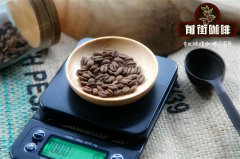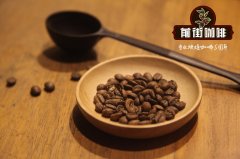The correct way to make Arabica Coffee how to make Arabica coffee tastes good

Professional coffee knowledge exchange More coffee bean information Please pay attention to coffee workshop (Weixin Official Accounts cafe_style)
Medium-bodied with tart and sweet notes
Medium bean body with sweet and sour flavor
100 Arabica coffee grown in Peru
100% Arabica coffee is grown in Peru.
Organic and Fair Trade Certified
Organic and Fair Trade Certification
Roasted and packed in the U.S.A
Baking and packaging in USA
Our AmazonFresh Fair Trade Organic Peru medium roast whole bean coffee is made with high quality 100 Arabica beans, expertly roasted and immediately packed for freshness. This medium-bodied coffee has brown sugar and chocolate notes 。
AmazonFresh Fair Trade Peruvian Coffee Medium Roast coffee beans are made from high quality 100 percent Arabica coffee beans. Clever roast and immediate packaging, medium bean coffee, brown sugar and chocolate blend aromas.
Here's a key secret to making great coffee. A simple formula: proper proportions, precise grinding, quality water and fresh coffee. This combination can be used at home, no matter how you brew your coffee. Learn more about these four essential ingredients and you can always brew coffee of consistent quality.
1. proportion
A great coffee mix is freshly ground 10g coffee with 180ml water. Keep this ratio consistent no matter how much coffee you brew. If this ratio is too strong for you, add a small amount of hot water and reduce the amount of coffee next time to find the ratio that works for you.
2. grinding
If you don't know what grind to use, just think about the brewing method you choose. Coffee grind directly affects how long coffee powder needs to be in contact with water. Espresso machines, for example, require very finely ground Arabica coffee. One rule: the finer the grind, the shorter the brewing time. If you don't know what grind you should use, don't worry about the free grind, just note your brewing method (French press, hand brewer, drip coffee machine, espresso machine, etc.).
3. water
98% of coffee is water. Therefore, it is very important to ensure that it tastes clean, fresh and free of impurities. Filtered or bottled water is a great option, but if you're using tap water, make sure it's cold and heat the water to 90-95 ° C almost boiling so you can extract coffee in all flavors.
4. fresh
Open packaged coffee is like fresh produce. Keep it fresh. Keep it in an airtight container. The trick is to keep it away from oxygen, light, heat and water. We recommend buying beans and drinking them freshly ground to ensure they taste fresh. After opening the package, coffee powder can be stored for one week and coffee beans can be stored for one month. Professional coffee preservation tanks (Friis® stainless steel coffee powder sealed tank can store 453g beans/500 powder) can greatly extend the coffee preservation time.
The French press is one of the easiest and most delicious ways to brew coffee. Using a portable press will get more of the coffee's natural oils than filter paper, which means richer flavor.
1. Arabica coffee with the correct grind
Using a French press requires coarsely ground coffee because it will be soaked in water for a long time. Ideally, it should be as thick as kosher salt.
2. Coffee and water mix right
For every 10g of coffee powder add 180ml of water.
3. add hot water
Use freshly boiled water.
4. stirred
Stir quickly with a spoon to make sure all of the coffee touches the water.
5. Set up filter components
Pull out the pull rod and cover the piston strainer and lid vertically. don't press it yet.
6. Wait 4 minutes
It is recommended to use a kitchen timer to ensure proper soaking.
7. Press the lever.
Slowly press down on the lever.
8. Please enjoy immediately.
Step1 Drink water:
Clean your mouth and taste buds before you taste coffee.
Step2 Smell:
Most human taste is produced by the nose, not the tongue, which can distinguish only four flavors: sweet, sour, bitter and salty. The nose can distinguish thousands of flavors, so before you taste coffee, smell its aroma and try to remember which flavor resembles it in your mind.
Step3 Drink:
When you taste coffee, it is very important to sip. As you sip coffee, it spreads on your tongue.
Step4 Feeling:
At this stage, think about where coffee tastes on your tongue. Do you feel the taste of coffee on both sides of your tongue? The tip of the tongue is in charge of sweetness; the side of the tongue is in charge of sourness and saltiness; and the root of the tongue is in charge of bitterness.
Step5 Share:
Another important step in tasting Arabica coffee is to share your feelings with the people present. Using your experience, you can divide the taste into four parts: aroma, acidity, concentration and flavor. Through this process, every time you drink coffee becomes very enjoyable.
AROMA(Aroma):
Aroma is the first thing you feel before you taste coffee. In fact, 90% of our feelings come from smell, which is why we experience coffee so differently.
ACIDITY:
The seeds produce a refreshing and lively feeling in your mouth, just like the difference between regular drinking water and sparkling water.
BODY(Concentration) :
refers to the weight or consistency of the beverage on your tongue, representing a range of concentrations from light to heavy.
Arabica Coffee FLAVOR(Flavor):
Overall impression of aroma, acidity and concentration.
Important Notice :
前街咖啡 FrontStreet Coffee has moved to new addredd:
FrontStreet Coffee Address: 315,Donghua East Road,GuangZhou
Tel:020 38364473
- Prev

The difference between Arabica Coffee and Robusta Coffee Fine Coffee specifically Arabica Coffee
Professional coffee knowledge exchange more coffee bean information Please follow the coffee workshop (Wechat official account cafe_style) in many coffee packaging or coffee advertising, you can see a sentence: we use 100% Arabica coffee beans, many people know what Arabica is, but why use Arabica coffee beans? Are Arabica coffee beans necessarily good coffee beans?
- Next

Introduction of African coffee beans description of African coffee beans introduction of African coffee bean producing areas
Professional coffee knowledge exchange more coffee bean information please follow coffee workshop (Wechat official account cafe_style) Tanzania Coffee Coffee growing area: African Coffee species: medium concentration Coffee description: refreshing acidity and medium mellow complement blackcurrant and sweet orange flavors: washing with flavors: blackcurrant, orange and lemon-like coffee
Related
- Beginners will see the "Coffee pull flower" guide!
- What is the difference between ice blog purified milk and ordinary milk coffee?
- Why is the Philippines the largest producer of crops in Liberia?
- For coffee extraction, should the fine powder be retained?
- How does extracted espresso fill pressed powder? How much strength does it take to press the powder?
- How to make jasmine cold extract coffee? Is the jasmine + latte good?
- Will this little toy really make the coffee taste better? How does Lily Drip affect coffee extraction?
- Will the action of slapping the filter cup also affect coffee extraction?
- What's the difference between powder-to-water ratio and powder-to-liquid ratio?
- What is the Ethiopian local species? What does it have to do with Heirloom native species?

